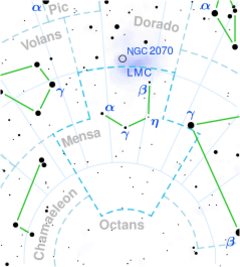Astronomy:Nu Mensae
| Observation data Equinox J2000.0]] (ICRS) | |
|---|---|
| Constellation | Mensa |
| Right ascension | 04h 20m 58.0721s[1] |
| Declination | −81° 34′ 47.719″[1] |
| Apparent magnitude (V) | 5.76±0.01[2] |
| Characteristics | |
| Spectral type | F0/2 III[3] |
| U−B color index | +0.05[4] |
| B−V color index | +0.35[4] |
| Astrometry | |
| Radial velocity (Rv) | 9.1±2.8[5] km/s |
| Proper motion (μ) | RA: +10.182[1] mas/yr Dec.: +125.469[1] mas/yr |
| Parallax (π) | 18.4754 ± 0.0273[1] mas |
| Distance | 176.5 ± 0.3 ly (54.13 ± 0.08 pc) |
| Absolute magnitude (MV) | +2.13[6] |
| Details | |
| Mass | 1.69[7] M☉ |
| Radius | 2.3[8] R☉ |
| Luminosity | 11.5[9] L☉ |
| Surface gravity (log g) | 3.94[7] cgs |
| Temperature | 6,921±139[7] K |
| Metallicity [Fe/H] | −0.08[7] dex |
| Rotational velocity (v sin i) | 108±5[6] km/s |
| Age | 1.7[7] Gyr |
| Other designations | |
| Database references | |
| SIMBAD | data |
Nu Mensae, Latinized from ν Mensae, is a solitary[10] star situated in the southern circumpolar constellation Mensa. It has an apparent magnitude of 5.76,[2] making it faintly visible to the naked eye. The star is relatively close at a distance of 176 light years[1] but is receding with a heliocentric radial velocity of 9.1 km/s.[5]
Nu Mensae has a stellar classification of F0/2 III,[3] indicating that it is a giant star with a spectrum intermediate between that of an F0 and F2 star. The star has an angular diameter of 0.41±0.03 mas,[11] and a radius 2.39 times that of the Sun at its estimated distance.[8] At present it has 169% the mass of the Sun[7] and shines at 11.5 times the luminosity of the Sun[9] at an effective temperature of 6,921 K,[7] giving it a white glow with a yellow tint. Despite an age of 1.7 billion years,[7] Nu Mensae spins rapidly with a projected rotational velocity of 108 km/s[6] and is slightly metal deficient relative to the Sun.[7]
References
- ↑ 1.0 1.1 1.2 1.3 1.4 1.5 Brown, A. G. A. (2021). "Gaia Early Data Release 3: Summary of the contents and survey properties". Astronomy & Astrophysics 649: A1. doi:10.1051/0004-6361/202039657. Bibcode: 2021A&A...649A...1G. Gaia EDR3 record for this source at VizieR.
- ↑ 2.0 2.1 Høg, E.; Fabricius, C.; Makarov, V. V.; Urban, S.; Corbin, T.; Wycoff, G.; Bastian, U.; Schwekendiek, P. et al. (March 2000). "The Tycho-2 catalogue of the 2.5 million brightest stars". Astronomy:Astronomy and Astrophysics 355: L27–L30. ISSN 0004-6361. Bibcode: 2000A&A...355L..27H.
- ↑ 3.0 3.1 Houk, N.; Cowley, A. P. (1975). University of Michigan Catalogue of two-dimensional spectral types for the HD stars. Volume I. Declinations -90_ to -53_ƒ0.. Bibcode: 1975mcts.book.....H.
- ↑ 4.0 4.1 Johnson, H. L.; Mitchell, R. I.; Iriarte, B.; Wisniewski, W. Z. (1966). "UBVRIJKL Photometry of the Bright Stars". Communications of the Lunar and Planetary Laboratory 4: 99–110. Bibcode: 1966CoLPL...4...99J.
- ↑ 5.0 5.1 Gontcharov, G. A. (November 2006). "Pulkovo Compilation of Radial Velocities for 35 495 Hipparcos stars in a common system". Astronomy Letters 32 (11): 759–771. doi:10.1134/S1063773706110065. ISSN 1063-7737. Bibcode: 2006AstL...32..759G.
- ↑ 6.0 6.1 6.2 Ammler-von Eiff, M.; Reiners, A. (June 2012). "New measurements of rotation and differential rotation in A-F stars: are there two populations of differentially rotating stars?". Astronomy & Astrophysics 542: A116. doi:10.1051/0004-6361/201118724. ISSN 0004-6361. Bibcode: 2012A&A...542A.116A.
- ↑ 7.0 7.1 7.2 7.3 7.4 7.5 7.6 7.7 7.8 Casagrande, L.; Schönrich, R.; Asplund, M.; Cassisi, S.; Ramírez, I.; Meléndez, J.; Bensby, T.; Feltzing, S. (June 2011). "New constraints on the chemical evolution of the solar neighbourhood and Galactic disc(s): Improved astrophysical parameters for the Geneva-Copenhagen Survey⋆". Astronomy & Astrophysics 530: A138. doi:10.1051/0004-6361/201016276. ISSN 0004-6361. Bibcode: 2011A&A...530A.138C.
- ↑ 8.0 8.1 Stassun, Keivan G. et al. (2019-10-01). "The Revised TESS Input Catalog and Candidate Target List". The Astronomical Journal 158 (4): 138. doi:10.3847/1538-3881/ab3467. ISSN 0004-6256. Bibcode: 2019AJ....158..138S.
- ↑ 9.0 9.1 Brown, A. G. A. (August 2018). "Gaia Data Release 2: Summary of the contents and survey properties". Astronomy & Astrophysics 616: A1. doi:10.1051/0004-6361/201833051. Bibcode: 2018A&A...616A...1G. Gaia DR2 record for this source at VizieR.
- ↑ Eggleton, P. P.; Tokovinin, A. A. (September 2008), "A catalogue of multiplicity among bright stellar systems", Monthly Notices of the Royal Astronomical Society 389 (2): 869–879, doi:10.1111/j.1365-2966.2008.13596.x, Bibcode: 2008MNRAS.389..869E
- ↑ Lafrasse, Sylvain; Mella, Guillaume; Bonneau, Daniel; Duvert, Gilles; Delfosse, Xavier; Chesneau, Olivier; Chelli, Alain (16 July 2010). "Building the 'JMMC Stellar Diameters Catalog' using SearchCal". Optical and Infrared Interferometry II. 7734. pp. 77344E. doi:10.1117/12.857024. Bibcode: 2010SPIE.7734E..4EL.
 |


